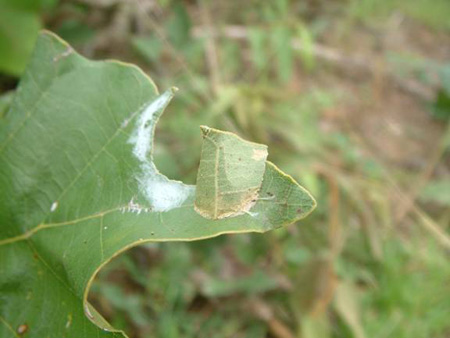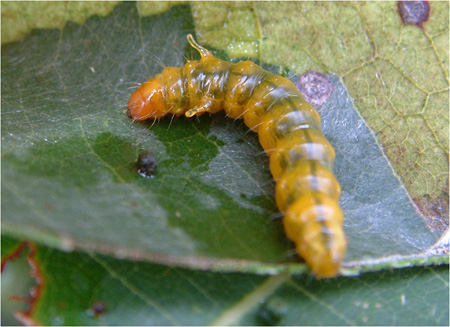Discovery of jumping behaviour in a caterpillar, Calindoea trifascialis, in Vietnam
Former ROM grad student Kim Humphreys (lead author) and I recently published an article in the scientific journal Biology Letters describing yet another fascinating behavior of the caterpillar Calindoea trifascialis.
This caterpillar lives in the hot, dry open forests of southern Vietnam and feeds on the leaves of dipterocarp trees. But it does not feed in the open – each caterpillar constructs a conical retreat on the surface of a leaf and feeds on the leaf surface while within the tent. [Darling, DC, 2003, Zootaxa, 225, 1-16].

Remarkably, the caterpillars have lateral appendages, like tiny drumsticks, near the front of the body. Not only are these structures unique for caterpillars, but a detailed study showed that Calindoea trifascialis caterpillars are chemically defended and use the appendages to smear compounds containing cyanide on any would-be attackers, most notably ants. The caterpillars also use these appendages to coat their body with these volatile defensive chemicals, allowing them to feed protected in their tents. [Darling, DC, FC Schroeder, J Meinwald, M Eisner, T Eisner, 2001, Naturwissenschaften, 88, 306-309].

If that wasn’t enough neat biology for one caterpillar, what occurs at the end of feeding is truly amazing – and the subject of the recent paper. The caterpillar constructs a different type of retreat on the leaf, which detaches and falls to the forest floor during the night. It then begins to jump, retreat and all, for 2-3 days, in an oriented manner. The paper in Biology Letters provides a detailed description of this behaviour and discusses experiments designed to get at the evolutionary benefit of jumping in the context of living in the dry dipterocarp forests.
Watch video clips to see the caterpillar in action. In one of the videos the leaf was replaced with a clear plastic “leaf” so that we could see the piston-like action of the caterpillar. It attaches itself with silk to one end of the retreat with hooks and then jumps, pushing the retreat airborne. To reverse direction, it detaches from the silk, turns around and attaches itself to the other end and then jumps in the opposite direction. We’ve never seen or heard of another caterpillar that engages in this most unusual behavior.
One caterpillar with three remarkable and heretofore unknown behaviours, each related to its growth and survival. How many other fascinating, undiscovered stories are there waiting to be discovered in these forests? Wilderness in Southeast Asia is quickly vanishing, so fieldwork by naturalists who can help reveal these wonders is all the more important.
Watch the below YouTube videos of Calindoea trifascialis caterpillars jumping
Caterpillar enclosed in pupal retreat on a leaf ; caterpillar and retreat jumping; exposed caterpillar showing the piston-like movement that results in the jumps.
Caterpillar jumping in a clear plastic “leaf” roll; note the caterpillar turns around in the roll to change direction
Tracking the path of the caterpillar through time
A group of caterpillars jumping in their retreats
A jumping caterpillar changes direction; during the pause the caterpillar is switching its position in the retreat.
Kim Humphreys is currently chasing caterpillars in Vietnam. To learn more about Dr. Chris Darling, Senior Curator (Entomology), see the biography online on the ROM’s website.
Media Coverage
- Caterpillar does not look where it leaps, BBC Nature
- Move Over, Mesican Jumping Beans - There's a new Jumping Caterpillar in Town, Scientific American
- Video: Jumping Cocoons Save Caterpillars' Lives, Science
- Jumpy Caterpillar shies the Sun: study, NewsDaily
- Jumping caterpillar stays out of the Sun, ABC Science
- Caterpillar Can Hop for 3 Days in Leafy 'Sleeping Bag', Live Science
